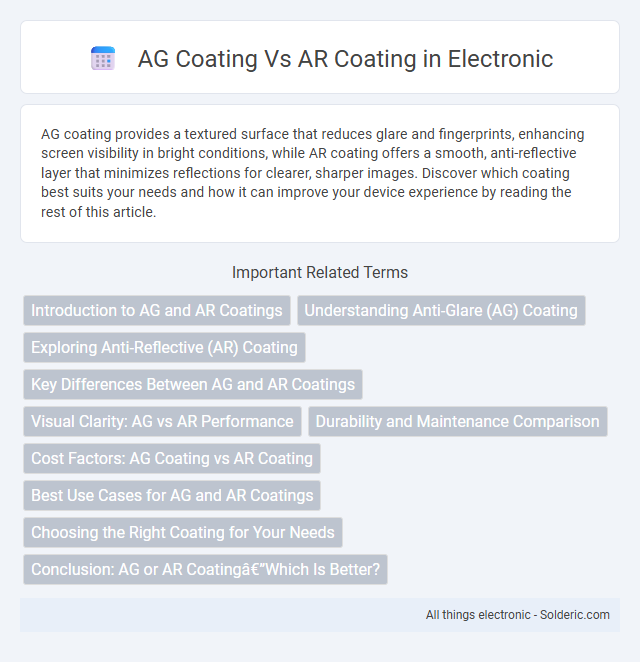AG coating provides a textured surface that reduces glare and fingerprints, enhancing screen visibility in bright conditions, while AR coating offers a smooth, anti-reflective layer that minimizes reflections for clearer, sharper images. Discover which coating best suits your needs and how it can improve your device experience by reading the rest of this article.
Comparison Table
| Feature | AG Coating (Anti-Glare) | AR Coating (Anti-Reflective) |
|---|---|---|
| Primary Purpose | Reduces surface glare and reflections | Minimizes light reflection on lens surfaces |
| Effect on Vision | Improves screen visibility by diffusing light | Enhances clarity and color contrast |
| Surface Texture | Matte, slightly rough finish | Clear, smooth, and transparent finish |
| Common Use | Computer screens, eyewear to reduce glare | Camera lenses, eyeglasses, smartphone screens |
| Durability | May attract dust and fingerprints | Typically has hydrophobic and oleophobic layers |
| Light Transmission | May reduce brightness slightly | Increases light transmission for clearer vision |
Introduction to AG and AR Coatings
Anti-glare (AG) coatings reduce surface reflection and improve visibility by scattering light, making screens and lenses easier to view in bright environments. Anti-reflective (AR) coatings minimize light reflection through interference, enhancing clarity and brightness while reducing eye strain. Both coatings serve distinct purposes in optics, with AG coatings prioritizing glare reduction and AR coatings enhancing light transmission.
Understanding Anti-Glare (AG) Coating
Anti-Glare (AG) coating reduces surface reflections by creating a textured layer that diffuses incoming light, enhancing screen visibility in bright environments. This coating improves readability and reduces eye strain by minimizing glare without significantly affecting color accuracy. Compared to Anti-Reflective (AR) coating, which uses thin-film interference to cancel reflections, AG coating provides a matte finish that scatters light rather than eliminating it entirely.
Exploring Anti-Reflective (AR) Coating
Exploring Anti-Reflective (AR) coating reveals its primary benefit in reducing glare and reflections on lenses or screens, enhancing visual clarity and comfort. Compared to Anti-Glare (AG) coating, AR coating improves light transmission by minimizing surface reflections, which enhances color accuracy and sharpness. You can achieve better eye strain reduction and improved viewing experience, especially in bright or high-glare environments, with specialized AR coatings tailored for glasses or electronic displays.
Key Differences Between AG and AR Coatings
AG (Anti-Glare) coatings reduce surface reflections by creating microscopic textures that scatter light, resulting in minimized glare and enhanced screen visibility under bright conditions. AR (Anti-Reflective) coatings use thin-film layers to suppress reflected light waves, improving light transmission and clarity without altering surface texture. AG coatings excel in preventing fingerprints and smudges, while AR coatings prioritize optical clarity and color accuracy on lenses and screens.
Visual Clarity: AG vs AR Performance
Anti-Glare (AG) coatings reduce surface reflections by diffusing light, which minimizes glare but can slightly soften the visual clarity and sharpness of your display. Anti-Reflective (AR) coatings use multiple ultra-thin layers to eliminate reflections and enhance light transmission, delivering clearer, sharper visuals with improved contrast and color accuracy. When prioritizing pure visual clarity and vivid image quality, AR coatings generally outperform AG coatings due to their superior reflection suppression and clarity enhancement.
Durability and Maintenance Comparison
AG (Anti-Glare) coatings typically offer higher durability due to their thicker, more robust surface treatments that resist scratches and smudges effectively. AR (Anti-Reflective) coatings, while excellent at reducing reflections and enhancing clarity, tend to be more delicate and require careful maintenance to avoid damage or degradation over time. Both coatings benefit from gentle cleaning techniques, but AG coatings generally demand less frequent upkeep and demonstrate longer-lasting performance in everyday use environments.
Cost Factors: AG Coating vs AR Coating
AG coating typically incurs higher manufacturing costs due to its complex etching process that creates a matte finish, while AR coating involves applying thin layers designed to reduce reflections at a lower price point. The material and application methods for AG coatings demand more precision and durability testing, contributing to increased expenses compared to the relatively simpler AR coatings. Cost efficiency for AR coatings makes them more common in consumer electronics, whereas AG coatings are favored in premium displays despite the premium cost.
Best Use Cases for AG and AR Coatings
AG coating excels in environments with frequent smudges and fingerprints, making it ideal for touchscreens, smartphones, and eyeglasses used in everyday activities. AR coating significantly improves optical clarity and reduces reflections, perfect for camera lenses, sunglasses, and optical instruments requiring enhanced visibility. Your choice between AG and AR coatings depends on whether you prioritize smudge resistance or glare reduction in your device or eyewear.
Choosing the Right Coating for Your Needs
AG coating (Anti-Glare) minimizes reflections and diffuses light to reduce glare, making it ideal for screens and lenses used in bright environments or outdoor settings. AR coating (Anti-Reflective) targets specific wavelengths to enhance light transmission and clarity, perfect for eyewear, camera lenses, and optical instruments that require maximum visual sharpness. Selecting between AG and AR coatings depends on whether reducing glare or improving transparency and brightness aligns better with your primary use case.
Conclusion: AG or AR Coating—Which Is Better?
Matte AG (Anti-Glare) coatings excel at reducing reflections and glare on screens, making them ideal for environments with bright lighting or outdoor use. AR (Anti-Reflective) coatings enhance screen clarity and contrast by minimizing surface reflections without compromising color accuracy. Choosing between AG and AR coatings depends on specific usage needs, with AG suited for glare reduction and AR preferred for superior visual sharpness.
AG coating vs AR coating Infographic

 solderic.com
solderic.com